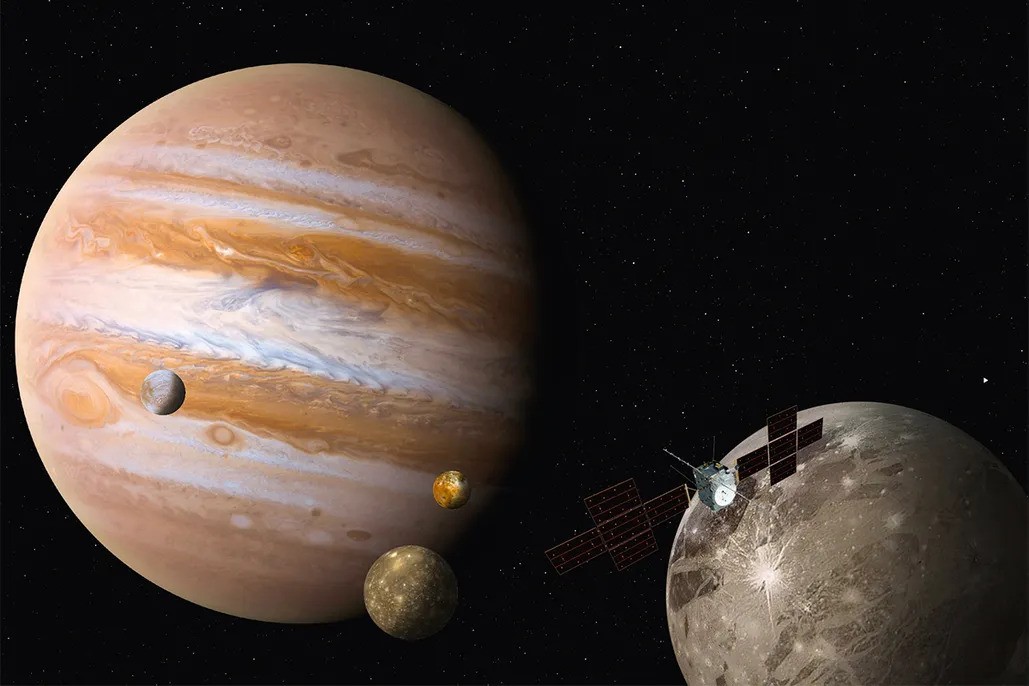Scientists have made sure that the Juice spacecraft will be able to perform a rendezvous maneuver with Jupiter’s moon Callisto in 2031. They conducted a rehearsal of this event with a copy of the probe’s control system, which remained on Earth and it was able to do everything right.

Juice — spacecraft for exploring the moons of Jupiter
Seven years later, in April 2031, ESA’s Juice mission will fly past Jupiter’s moon Callisto, offering scientists a tantalizing view of a mysterious, cratered alien world. This may seem like a distant prospect, but in the world of space exploration, it’s never too early to start preparing.
Teams at the ESOC mission operations center in Germany recently conducted a dress rehearsal with Juice for the Callisto flyby to test the mission’s autonomous navigation software. When Juice arrives in the Jupiter system, a long delay in communication with Earth will mean that it will not be able to afford to wait for a response from mission control if something goes wrong.
Although we have a good idea of where Callisto will be in April 2031, we do not know its position precisely enough to ensure that the trajectory of Juice will take it through Callisto’s gravitational field exactly as it should, and will allow it to be perfectly aligned for high-precision scientific measurements. Even a tiny discrepancy can have terrible consequences for science, as some Juice instruments must be pointed at certain areas of Callisto with an accuracy of a tiny fraction of a degree to make their measurements.
“We need Juice to be able to react with its own ‘eyes’ and its own ‘brain’,” says Ignacio Tanco, Juice’s director of flight operations. “When Callisto appears in the field of view of its navigation camera, it needs to be able to identify important features on the moon’s surface, rotate itself to point its instruments at them, and then continue rotating to keep them in view as it flies past.”
Juice Engineering Model
ESA teams are flying spacecraft to new and interesting destinations across the Solar System. To prepare for important operations, as well as to diagnose and solve problems faced by spacecraft millions of kilometers away, they use a one-of-a-kind replica that remains on Earth. This “engineering model” is an exact replica of the hardware, software, electrical systems and instruments that are sent into deep space.
Therefore, in fact, the spacecraft traveling in the depths of space was not misled by anyone. The Juice team used its engineering model to test autonomous navigation software that would point it the way in the Jupiter system.
Scientists “tricked” it into believing that it was on Callisto by projecting a series of moon images onto an exact replica of the spacecraft’s navigation camera to see how it would react. They received high-resolution images generated by a computer model that depicted Callisto in the same orientation and phase in which Juice would see it when it arrived seven years later.
The navigation software had to respond to these images. If it noticed that it was approaching Callisto from the wrong angle or looking slightly in the wrong direction, the program had to try to correct these mistakes without the help of engineers.
Complex test
Teams from ESA and Juice manufacturer, Airbus, have allocated three days for the test flight to Callisto. Spacecraft operators, scientists, mechanical engineers, electricians, and programmers all expected to spend days encountering problems and solving them before finally reaching a clean flyby in which Juice would react exactly the way they wanted.
To make this test even more difficult, they did not have access to one of the most important instruments in the spacecraft control toolkit. Usually, before conducting a complex test on a physical engineering model of a spacecraft, it is first launched on a fully digital software simulator of the spacecraft, which has no physical parts.
Now the Juice team needs to confirm that the flight model behaves exactly the same as the engineering one by conducting a similar test in space. However, the only way to track a large object using the Juice navigation camera will appear during its planetary flights. The upcoming gravitational maneuver of the spacecraft near the Earth and Moon in August of this year is not an option for this test.
During this double flyby, Juice will fly past the Moon and then the Earth in less than 24 hours to gain energy from the gravity of both bodies. This is a very delicate maneuver that has never been attempted before, and all members of the mission team must be ready to respond to every anomaly at any moment.
According to phys.org
Follow us on Twitter to get the most interesting space news in time
https://twitter.com/ust_magazine


